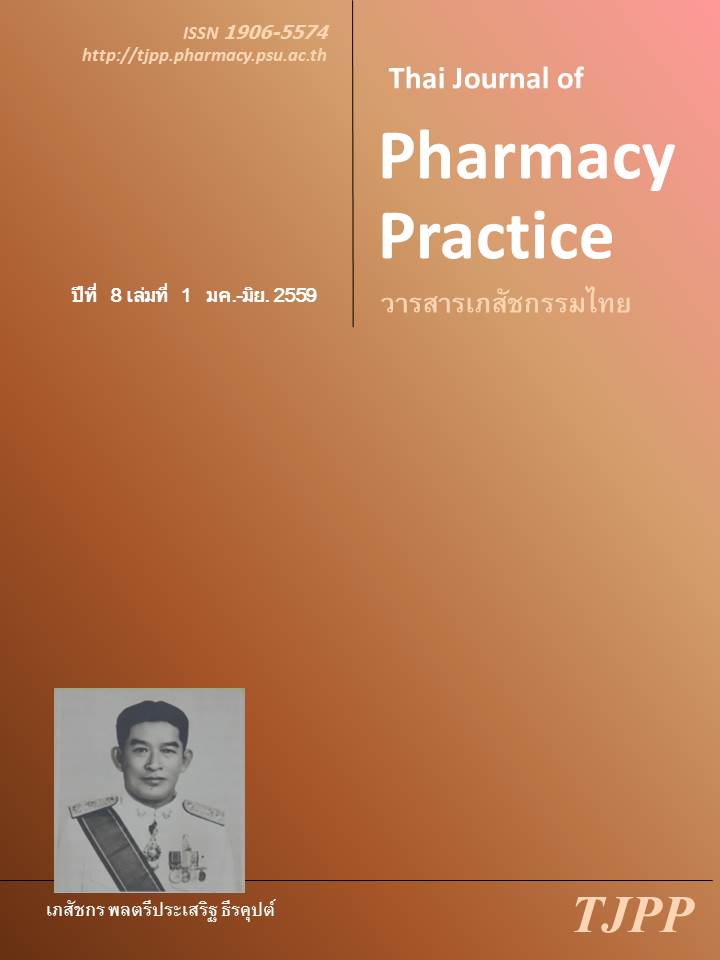ผลของกระบวนการสร้างความสอดคล้องต่อเนื่องทางยา ณ หอผู้ป่วยศัลยกรรมของโรงพยาบาลศูนย์แห่งหนึ่ง
Main Article Content
บทคัดย่อ
วัตถุประสงค์: เพื่อศึกษาความแตกต่างระหว่างรายการยาที่แพทย์สั่งใช้กับรายการยาที่ผู้ป่วยได้รับ ความคลาดเคลื่อนทางยาที่เกิดจากความแตกต่างของรายการยาดังกล่าว การแก้ไขความคลาดเคลื่อนทางยาที่เกิดขึ้น และเวลาที่ใช้ในขั้นตอนแรกรับและจำหน่ายหลังจากพัฒนาแนวทางการสร้างความสอดคล้องต่อเนื่องทางยาในหอผู้ป่วยทางศัลยกรรมของโรงพยาบาลศูนย์แห่งหนึ่ง วิธีการ: ผู้วิจัยเก็บข้อมูลจากผู้ป่วย 219 รายที่มีการรักษาตัวในโรงพยาบาล 230 ครั้ง ระหว่างเดือนมกราคม-มีนาคม 2555 เภสัชกรประสานงานกับแพทย์เมื่อพบความแตกต่างของรายการยาที่ผู้ป่วยได้รับในโรงพยาบาลและยาที่ได้รับก่อนเข้ารักษาตัว เพื่อหาสาเหตุของความแตกต่างดังกล่าว และพิจารณาว่าเป็นความคลาดเคลื่อนทางยาหรือไม่ ผู้วิจัยประเมินความรุนแรงของผลลัพธ์ทางคลินิกที่เกิดขึ้นจากความคลาดเคลื่อนทางยาโดยใช้เกณฑ์ของ National Coordinating Council for Medication Errors Reporting and Prevention (NCCMERP) ผลการวิจัย: ขณะแรกรับผู้ป่วยเข้ารักษาในโรงพยาบาลและจำหน่ายพบความแตกต่างของรายการยาร้อยละ 60.7 และร้อยละ 29.2 ของจำนวนรายการยาทั้งหมด ตามลำดับ การศึกษาพบความคลาดเคลื่อนทางยาร้อยละ 25.2 ของจำนวนครั้งในการเข้ารับการรักษา โดยคิดเป็นความคลาดเคลื่อนขณะแรกรับและขณะจำหน่าย ร้อยละ 20.9 และร้อยละ 4.3 ตามลำดับ ความคลาดเคลื่อนที่พบในงานวิจัยมีจำนวน 237 รายการจากรายการยาทั้งหมด 1,605 รายการ โดยเป็นประเภทผู้ป่วยไม่ได้รับยาที่สมควรจะได้รับ 228 ครั้ง (ร้อยละ 96.2 ของความคลาดเคลื่อนที่พบทั้งหมด) ความแรงผิด 3 ครั้ง (ร้อยละ 1.3 ของความคลาดเคลื่อนที่พบทั้งหมด) ขนาดยาหรือความถี่ในการให้ยาผิด 3 ครั้ง (ร้อยละ 1.3 ของความคลาดเคลื่อนที่พบทั้งหมด) รูปแบบยาผิด 2 ครั้ง (ร้อยละ 1.0 ของความคลาดเคลื่อนที่พบทั้งหมด) และตัวยาผิด 1 ครั้ง (ร้อยละ 0.5 ของความคลาดเคลื่อนที่พบทั้งหมด) ความคลาดเคลื่อนขณะแรกรับ 200 รายการ เป็นความรุนแรงระดับ B จำนวน 196 ครั้ง (ร้อยละ 98.0 ของความคลาดเคลื่อนที่พบทั้งหมดขณะแรกรับ) และระดับ C 4 ครั้ง (ร้อยละ 2.0 ของความคลาดเคลื่อนที่พบทั้งหมดขณะแรกรับ) ความคลาดเคลื่อนที่พบขณะจำหน่าย 37 รายการ เป็นความรุนแรงระดับ B ทั้ง 37 รายการ เวลาเฉลี่ยที่ใช้ในกระบวนการสร้างความสอดคล้องต่อเนื่องทางยา เท่ากับ 26.2+13.0 นาที/ผู้ป่วย 1 ราย โดยเป็นเวลาที่ใช้ขณะแรกรับและจำหน่าย 15.2±10.0 นาที และ 11.0±5.0 นาที ตามลำดับ สรุป: กระบวนการสร้างความสอดคล้องต่อเนื่องทางยาในหอผู้ป่วยศัลยกรรมโดยเภสัชกรทำให้พบความคลาดเคลื่อนทางยาที่นำไปสู่การจัดการเพื่อเพิ่มความปลอดภัยให้กับผู้ป่วยในระหว่างที่เข้ารับการรักษาและจำหน่ายออกจากโรงพยาบาล
Article Details
ผลการวิจัยและความคิดเห็นที่ปรากฏในบทความถือเป็นความคิดเห็นและอยู่ในความรับผิดชอบของผู้นิพนธ์ มิใช่ความเห็นหรือความรับผิดชอบของกองบรรณาธิการ หรือคณะเภสัชศาสตร์ มหาวิทยาลัยสงขลานครินทร์ ทั้งนี้ไม่รวมความผิดพลาดอันเกิดจากการพิมพ์ บทความที่ได้รับการเผยแพร่โดยวารสารเภสัชกรรมไทยถือเป็นสิทธิ์ของวารสารฯ
เอกสารอ้างอิง
2. Tam V, Knowles S, Cornish P, Fine N, Marchesano R, Etchells E. Frequency, type and clinical importance of medication history errors at admission to hospital: a systematic review. Can Med Assoc J 2005; 173: 510.
3. Bates DW, Spell N, Cullen DJ, Burdick E, Laird N, Petersen LA, et al. The costs of adverse drug events in hospitalized patients. JAMA 1997; 277: 307-11.
4. Ningsanon T. Medication reconciliation. In: Ningsa- non T, Montakantikul P, Chulavatnatol S, editors. Medication reconciliation. Thailand: Prachachon; 2008. p. 2-26.
5. Unroe KT, Pfeiffenberger T, Riegelhaupt S, Jastrzembski J, Lokhnygina Y, Colon-Emeric C. Inpatient medication reconciliation at admission and discharge: A retrospective cohort study of age and other risk factors for medication discrepan- cies. Am J Geriatr Pharmac 2010;8:115-26.
6. Kaeokumbong C. The effects of medication reconciliation in an inpatient unit of a community hospital. Thai Journal of Pharmacy Practice 2009; 1: 162-71.
7. Rachada J. Development of medication reconcile- ation process in inpatient setting at Maha Sarakham hospital [master thesis]. Khonkaen: Khon Kaen University; 2010.
8. Suetrong C. Developing and implementing medi- cation reconciliation process following transition points in inpatient medication system [master thesis]. Bangkok: Chulalongkorn University; 2005.
9. Seesuk P. Effects of medication reconciliation process in inpatient setting at a community hospital in Trang provinces [master thesis]. Songkla: Prince of Songkla University; 2009.
10. Chujun P. Effects of medication reconciliation process at a community hospital inpatient setting in Nakhon Si Thammarat province [master thesis]. Songkla: Prince of Songkla University; 2009.
11. Nitjaphan S. The effects of medication reconcile- ation process in inpatient setting at a community hospital in pattalung province [master thesis]. Songkla: Prince of Songkla University; 2009.
12. Rattanasaigam A. Effects of medication reconcile- ation process at a community hospital in-inpatient setting in Pattani province [master thesis]. Songkla: Prince of Songkla University; 2009.
13. Gleason K, McDaniel M, Feinglass J, Baker D, Lindquist L, Liss D, et al. Results of the medica- tions at transitions and clinical handoffs (MATCH) Study: An analysis of medication reconciliation errors and risk factors at hospital admission. J Gen Intern Med 2010;25:441-7.
14. Saepang K. Effects of inpatient medication reconciliation process in a community hospital in Trang province [master thesis]. Songkla: Prince of Songkla University; 2009.
15. Rozich J, Resar R. Medication safety: one organization's approach to the challenge. JCOM 2001; 8: 27-34.
16. Siwichi W. Outcomes of medication reconciliation on medication error in the inpatient setting at Maetha Hospital, Maetha District, Lamphun Province [master thesis]. Chiang Mai: Chiang Mai University; 2008.
17. Srisupanwitaya S. Outcomes of medication reconciliation complete process in surgical chronic disease patients at Samutprakarn Hospital [master thesis]. Bangkok: Chulalongkorn University; 2010.
18. Gleason KM, Groszek JM, Sullivan C, Rooney D, Barnard C, Noskin GA. Reconciliation of discrepa- ncies in medication histories and admission orders of newly hospitalized patients. AJHP 2004; 61: 1689-94.
19. The National Coordinating Council for Medication Error Reporting and Prevention. Definition of medication error. [cited 2006 Aug 8]; Available from: URL:http://www.nccmerp.org/aboutMedErrors .html.
20. Tatro DS. Drug interaction facts. St. Louis: Wolters Kluwer Health; 2008.


